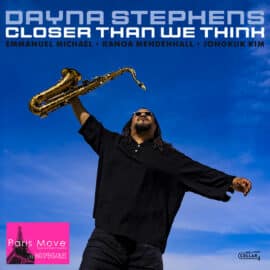| Jazz |

Dayna Stephens is an extraordinary saxophonist, composer, and monumental educator, enjoying well-deserved recognition in the contemporary scene. Mentored by legends such as Terence Blanchard, Wayne Shorter, and Herbie Hancock, Stephens made a name for himself by winning the DownBeat Critics Poll for Rising Star Tenor Saxophonist in 2019. He is active in the New York jazz scene, teaching at the Manhattan School of Music and William Paterson University.
Here’s what you need to know about this remarkable saxophonist, equally exciting despite working in a different style than saxophonist Céline Bonacina. The analogy one can draw with Wayne Shorter precisely reflects a similarly rich musical approach; indeed, Dayna does not seek to please but imposes his style, born from an absolute richness stemming from a diverse and extensive cultural background. Due to the pace of the contemporary world, creating a coherent list of peers and mentors wasn’t feasible, initially disappointing Stephens. “We all play better when we play with people we perceive to be better than us,” says Dayna Stephens. “The frustration of not being able to do this consistently with the same personnel every time – that was a hurdle I kept running into whenever I wanted to put something together.” But from this initial setback, a seed of inspiration began to sprout. Stephens – who is a full-time educator in some of America’s most prestigious music conservatories – thought about the places and people who had inspired him and realized that while he was inspired by his heroes, he received as much, if not more, inspiration from the students he had the privilege to teach. “When this paradigm shift occurred, there wasn’t really a question about the people I wanted to play with.”
Just these profound reflections show how deeply Dayna Stephens understands the foundation of an artist, which translates into this album with compositions and arrangements of extraordinary quality. Of course, this music is quite elitist; those seeking easily digestible tunes may pass it by, but others will have the pleasure not only of discovering the art of this saxophonist and composer but also his profound sensitivity.
Several composers’ works are featured on this album, and a distinct absence of piano can be noted on “Closer Than We Think.” When asked, Stephens remarked that much of the sonic palette of this album was inspired by Sonny Rollins’ timeless album, “The Bridge.” “My father bought me ‘The Bridge,’ and I fell in love, acknowledging the gravity, and sometimes even the playful and humorous expression that I felt from Sonny,” says Stephens. “This level of intimacy, warmth, and a sense of limitless possibilities is the source of my addiction to this music.” As for the saxophonist’s compositions, one of the tracks composed by Stephens on the album is “A New Spring,” emotionally linked to the composer himself. The melody was composed in Stephens’ head as he underwent one of his last dialysis sessions before receiving a kidney transplant. As Stephens sat in the dialysis chair, his brain spun the melody through a plethora of orchestration options, and each pleased him. Although it has been interpreted in different ways, the arrangement used on the album with its guitar-centric sonic landscape powerfully encapsulates the idea of reaching a new beginning.
Undoubtedly, this album is a reference for all fans of this musical genre, and as such, it becomes indispensable for enthusiasts of music with complex architecture.
Thierry De Clemensat
USA correspondent – Paris-Move and ABS magazine
Editor in chief Bayou Blue Radio, Bayou Blue News
PARIS-MOVE, March 15th 2024
::::::::::::::::::::::
